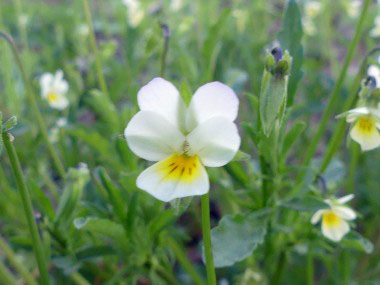





To support our efforts please browse our store (books with health benefits, etc.).
Field pansy is a native annual plant in the violet family found throughout most of North America. It is a winter annual weed that forms colonies. This plant attracts wildlife and is an early spring nectar source for bees. It is often confused with Heartsease (Johnny Jump Up) but it is not the same. Heartsease is Viola tricolor and is native to Europe.
Distinguishing Features
This plant has a very small, dainty-like flower with a distinct feature, the length of the sepals. Its petals are longer than the sepals, where other varieties of viola have petals that are shorter than the sepals. They typically grow in colonies so they are easy to spot.
Flowers
The field pansy flower is solitary, rising from the leaf axils on the stems. The flower has five dark veined petals, with bearded lateral petals and the lower petal typically has a yellow patch at its base. The petals are usually pale blue, however they can also be white with a slight blue tint. This is the only annual in the Violet species that self pollinates when the flower is closed. Each flower is about 1cm (½") across and has five sepals. This flower blooms mid-spring to early summer and lasts about 1½ months.
 Fields
of Nutrition has medicinal benefits and vitamin/mineral content of Field Pansy.
Fields
of Nutrition has medicinal benefits and vitamin/mineral content of Field Pansy.
Leaves
The alternate leaves are oblanceolate, or linear-oblanceolate, becoming narrow as they ascend the stems. They are up to 5cm (2") long, light to medium green, hairless, and smooth to slightly crenate along the margins. Leafy stipules up to 2.5 cm (1") long occur along the stems near the bases of the leaves.
Height
Field pansies grow to about 15 cm (6”) tall.
Habitat
These plants can be found in fields, along roadsides and other disturbed sites such as prairies, pastures. It tends to thrive in moist, sandy soils but will grow in a variety of soils. It prefers full sun but have adopted to part shade.
Edible Parts
Leaves and flowers are edible.
Other Name
American Field Pansy.
Similar Plants
Heartsease, Pansy.
Winter Survival Food Handbook

PDF Plant Magazines
Types of Wild Food
Geographic Zones Seasons
Disclaimer
EdibleWildFood.com is informational in nature. While we strive to be 100% accurate, it is solely up to the reader to ensure proper plant identification. Some wild plants are poisonous or can have serious adverse health effects.
We are not health professionals, medical doctors, nor are we nutritionists. It is up to the reader to verify nutritional information and health benefits with qualified professionals for all edible plants listed in this web site. Please click here for more information.
Why Edible Wild Food?
- Food costs are rising
- Free, wild food is readily abundant
- Wild food adds nutrition to your diet
- Wild food can help treat various medical conditions





